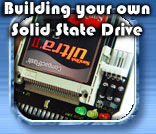1 - Introduction
Assemble a SSD disk for less than 75 EUR
 Guys and gals, face it; SSD (Solid State Drives) are up and coming, I mean everybody just adores the technology. See, there are no more moving parts in your "HD" so they'll break down at a much slower rate. Then there's the fact that the biggest SDD to date consumes 1.5 Watt, how lovely is that for your green ethics ?
Guys and gals, face it; SSD (Solid State Drives) are up and coming, I mean everybody just adores the technology. See, there are no more moving parts in your "HD" so they'll break down at a much slower rate. Then there's the fact that the biggest SDD to date consumes 1.5 Watt, how lovely is that for your green ethics ?
There are however two major deficits with SDD drives. The first being it's overall speed for reading and writing compared to the traditional HDD. A reasonably quality SSD is roughly half the speed of a normal HDD, if you are lucky. Though the 1000+ EUR SSDs are much faster and can reach speeds up-to 100MB/sec. The second deficit, the hideously expensive price tags on the SDD drives. Some companies charge you 1200 EUR/USD for a 32 GB drive. That's just amazing, especially when you consider that the technology used is identical toward the flash-memories being used on storage cards and flash drives.
And then there is endurance, flash memory, regardless of format, supports only a limited number of erase/write cycles before a particular "sector" can no longer be written. Memory specifications generally allow 10,000 to 1,000,000 write cycles. The past year or two, reliability increased significantly though. But what happens if a sector on that flash fails .. does the entire flash memory fail and would be useless you ask ? No, typically the controller in a CompactFlash attempts to prevent premature wear out of a sector by mapping the writes to various other sectors in the card - a process referred to as wear leveling, much like remapping bad-sectors on a traditional HDD. So you're data is pretty well protected.
So is an SSD drive interesting ? Absolutely .. but it's just not worth a grand now is it ?
So before you lay down a grand on the table, why not experiment a little yourself and build your own drive for roughly 75 EUR ? This way you can at the very least test if SDD is something you'd like, and we'll do exactly that with CompactFlash (CF) memory.
Why using CompactFlash you ask ? CompactFlash defines a physical interface which is smaller than, but electrically identical to the good old ATA interface. That is, it appears to the host device as if it were a hard disk of some defined size and has a tiny IDE controller on-board the CF device itself. See CompactFlash memory this can communicated directly to your DMA IDE interface, similar as the Parallel HDD we all still love so much. So pretty much all you need is some sort of device to make that IDE connection happen, and if you browse a little .. you'll find many of them.
These devices are called CF-IDE converters and if you visit e-bay, search a little .. you can find them dirt cheap. I ordered one through the Dutch e-bay partner Martkplaats, and IDE pluggable DUAL CF (two CFs can be used on this device) to IDE adapter. We can stick two CF's in there and get two SSD drives. There are two type CF 1 & CF II that relate to sheer product size (volume space of the flash). Then there are four main speeds of cards including the original CF, CF High Speed (using CF+/CF2.0), a faster CF 3.0 standard and a yet faster CF 4.0 standard that is being adopted as of 2007. The higher that number, the more expensive and faster the CFs will be.
- Revision 2.0 added an increase in speed to 16 MB/s data-transfer, according to the CompactFlash Association (CFA).
- Revision 3.0 supports up to a 66 MB/s data transfer rate, along with a number of other features.
- Revision 4.0 supports IDE Ultra DMA 133 for a maximum data transfer rate of 133 MB/s.
I paid a only 15 EUR for the CF II adapter, including shipping. That'll be the first product we'll test today.
The option above is the most simple and cheapest way to make a SDD unit. But for 45 EUR I bought an Addonics Quad CF PCI Controller. This controller will allow to have four CF's to be used and combine them in RAID. This promises to greatly enhance speed and overall reliability.
Let's have a go at it shall we ?

